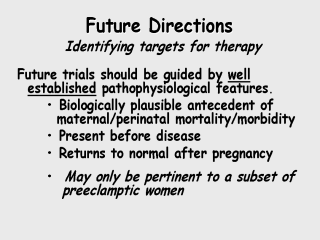 |
Based on that
information I would suggest that future trials should be guided by things that seem to be
well-established. The prostacyclin thromboxane theory was a little weak. Certainly in the
calcium trials a lot of money was spent on fairly weak data. You want the information to
be biologically plausible and also a biologically plausible antecedent of mother and baby
problems. That means in looking at changes that youíre going to be targeting, you want
these to be present before the disease, and you want whateverís present before the
disease to suggest it might be an important cause of the disease. It should get better
when the woman delivers. And itís always important that any sign that you look at before
disease may be very pertinent to a subset of women but not all the women. |
